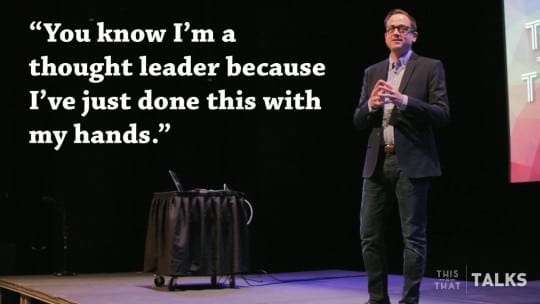
Any discussion of “thought leadership” should start with an acknowledgement that virtually everyone outside the communications field hates the term.
Editors and producers see it as a symbol of all that’s wrong with public relations. Even many in the communications industry have grown weary of the term, because it’s overused and gets slapped on picayune efforts that are neither thoughtful nor leading.
Cartoonists may be the only people who truly love the term, but that’s only because it’s so easy to lampoon.
Yet in spite of the cliché, positioning your executives as, well, leading thinkers remains a critical component of any successful corporate communications effort—especially when your company has passed the “media darling” stage when it’s making all the news.
How can you ensure success in this effort? Here are five key points:
1) Don’t assume everyone will want to talk about what you want to talk about. A smart approach to thought leadership starts with the understanding that few companies, organizations or individuals have the global influence to drive media conversations from start to finish. Rather than trying to control media discussions, you’ll find success by identifying and predicting the trajectory of the conversations occurring in the media, and using your content to insert a unique perspective.
2) Be willing to take a stand. By definition, if everyone agrees on a topic, then no one talking about it is leading anything. Leaders have to be willing to wade into controversy, balancing legitimate concerns about alienating investors, customers, regulators and other audiences by taking too firm a position on a hot-button issue. But a true thought leader stakes out a clear position on an issue, and defends it intelligently. You can be provocative without being reckless.
3) Know your audiences and how to reach them. One of the big selling points of thought leadership is the allure of seeing your byline in the Wall Street Journal, New York Times or Washington Post. And those are always fun hits to present to a client. But what if the people you need to reach aren’t reading those papers? A bylined article in a major industry publication or a speaking engagement at a small but influential conference can sometimes provide a better business return than an op-ed in the Journal or a spot on the TED Talk stage.
4) Always feature the human element. A timely news hook, airtight logic and a great set of statistics will get you a long way toward a compelling thought leadership piece—but editors, reporters and readers will always demand a real human face on the issue. To maximize the impact of the position you take in an op-ed, speech or interview, you need to demonstrate its real-world impact.
5) Remember that you’re not making a corporate sales pitch. One of the easiest ways to undermine your thought leadership piece is to insist your brand be in the spotlight. You’re playing the long game. Be willing to sacrifice the immediate payoff of mentioning your company or product for the long-term benefits of building your reputation as an insightful commentator on industry trends.
Christian Pinkston is founder and president of the Pinkston Group, Inc.
